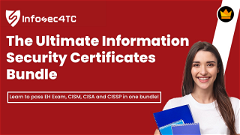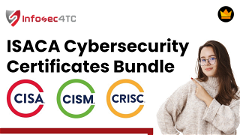Ethical Hacking From Scratch to Advanced Techniques
This course prepares you to the most advanced Ethical Hacker Exams. The goal of this course is to help you master an ethical hacker methodology that can be used in a penetration testing. By the end...
- All levels
- English

Course Description
This course prepares you to the most advanced Ethical Hacker Exams. The goal of this course is to help you master an ethical hacker methodology that can be used in a penetration testing. By the end of the course, you will have ethical hacker skills that are highly in demand, as well as the globally recognized Certifications. Make This Investment in Yourself If you want to do exciting work...
This course prepares you to the most advanced Ethical Hacker Exams.
The goal of this course is to help you master an ethical hacker methodology that can be used in a penetration testing. By the end of the course, you will have ethical hacker skills that are highly in demand, as well as the globally recognized Certifications.
Make This Investment in Yourself
If you want to do exciting work and enjoy the salaries that ethical hackers make, then this is the course for you!
Take this course to become a professional Ethical Hacker!
See more See lessWhat you’ll learn
- Introduction to Ethical Hacking
- Setup your lab (Install VMWARE Player)
- Setup your lab (Install and Configure the Lab)
- Linux
- What is Reconnaissance
- Reconnaissance (What Information you are looking for)
- Reconnaissance (Tools and Techniques)
- Reconnaissance (Advanced Resonance technique)
- Reconnaissance (Maltego)
- Introduction to Maltego
- Maltego (Using Maltego)
- Maltego (Related Entities in Maltego)
- Maltego (More Maltego)
- XHydra
Covering Topics | Program Insights
Section 1: Setup your lab
Section 2: Start to use Linux
Section 3: Reconnaissance
Section 4: Scanning
Section 5: Start Hacking
Section 6: Network Hacking
Section 7: Social Engineering
Section 8: Wireless Hacking
Section 9: Vulnerability and Exploit
Section 10: Buffer Overflow
Section 11: Web Application Hacking
Section 12: Malicious Code
Section 13: Denial of Service
Section 14: Bypassing Security
Section 15: Real Life Scenario
Curriculum
Frequently Asked Questions
This course includes
- Lectures 14
- Month 6 Month
- Language English
- Certificate No
Education Provider
More Courses

Ethical Hacker Bundle Cou.
- ₹ 3700

The CompTIA Cybersecurity.
- ₹ 4686

The Ultimate Information.
- ₹ 3650

ISACA: Cybersecurity Cert.
- ₹ 3600

The Ultimate Cloud Certif.
- ₹ 2730
